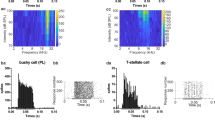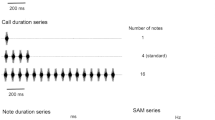Abstract
Many noctuid moth species perceive ultrasound via tympanic ears that are located at the metathorax. Whereas the neural processing of auditory information is well studied at the peripheral and first synaptic level, little is known about the features characterizing higher order sound-sensitive neurons in the moth brain. During intracellular recordings from the lateral protocerebrum in the brain of three noctuid moth species, Heliothis virescens, Helicoverpa armigera and Helicoverpa assulta, we found an assembly of neurons responding to transient sound pulses of broad bandwidth. The majority of the auditory neurons ascended from the ventral cord and ramified densely within the anterior region of the ventro-lateral protocerebrum. The physiological and morphological characteristics of these auditory neurons were similar. We detected one additional sound-sensitive neuron, a brain interneuron with its soma positioned near the calyces of mushroom bodies and with numerous neuronal processes in the ventro-lateral protocerebrum. Mass-staining of ventral-cord neurons supported the assumption that the ventro-lateral region of the moth brain was the main target for the auditory projections ascending from the ventral cord.









Similar content being viewed by others
References
Agee HR, Orona E (1988) Studies of the neural basis of evasive flight in Heliothiszea (Lepidoptera: Noctuidae): organization of the tympanic nerves. Ann Entomol Soc Am 81:977–985
Anton S, Evengaard K, Barrozo RB, Anderson P, Skals N (2011) Brief predator sound exposure elicits behavioral and neuronal long-term sensitization in the olfactory system of an insect. Proc Natl Acad Sci U S A 108:3401–3405
Boyan GS (1983) Postembryonic development in the auditory system of the locust: anatomical and physiological characterisation of interneurones ascending to the brain. J Comp Physiol [A] 151:499–513
Boyan GS, Fullard JH (1986) Interneurons responding to sound in the tobacco budworm moth Heliothis virescens (Noctuidae): morphological and physiological characteristics. J Comp Physiol [A] 158:391–404
Boyan GS, Willis L, Fullard J (1990) Organization in the thoracic ganglia of noctuid moths. J Comp Neurol 295:248–267
Fullard JH (1998) The sensory coevolution of moths and bats. In: Hoy RR, Popper AN, Fay RR (eds) Comparative hearing: insects. Springer, New York, pp 279–326
Gupta N, Stopfer M (2012) Functional analysis of a higher olfactory center, the lateral horn. J Neurosci 32:8138–8148
Homberg U, Montague RA, Hildebrand JG (1988) Anatomy of antenno-cerebral pathways in the brain of the sphinx moth Manduca sexta. Cell Tissue Res 254:255–281
Hoy RR, Robert D (1996) Tympanal hearing in insects. Annu Rev Entomol 41:433–450
Kamikouchi A, Shimada T, Ito K (2006) Comprehensive classification of the auditory sensory projections in the brain of the fruit fly Drosophila melanogaster. J Comp Neurol 499:317–356
Kvello P, Løfaldli BB, Rybak J, Menzel R, Mustaparta H (2009) Digital three dimensional average shaped atlas of the Heliothis virescens brain with integrated gustatory and olfactory neurons. Front Syst Neurosci 13:1–14
Lai JSY, Lo SJ, Dickson BJ, Chiang AS (2012) Auditory circuit in the Drosophila brain. Proc Natl Acad Sci U S A 109:2607–2612
Minet J, Surlykke A (2003) Auditory and sound producing organs. In: Kristensen NP (ed) Lepidoptera, moths and butterflies, vol 2. Morphology and physiology. de Gruyter, Berlin, pp 289–323
Nebeling B (2000) Morphology and physiology of auditory and vibratory ascending interneurons in bushcrickets. J Exp Zool 286:219–230
Olberg RM, Willis MA (1990) Pheromone-modulated optomotor response in male gypsy moths, Lymantria dispar L.: directionally selective visual interneurons in the ventral nerve cord. J Comp Physiol [A] 167:707–714
Ostrowski TD, Stumpner A (2010) Frequency processing at consecutive levels in the auditory system of bush crickets (Tettigoniidae). J Comp Neurol 518:3101–3116
Ostrowski TD, Stumpner A (2013) Processing of ultrasound in a bush cricket’s brain. Physiol Entomol 38:33–44
Paulk AC, Dacks AM, Phillips-Portillo J, Fellous JM, Gronenberg W (2009)Visual processing in the central bee brain.J Neurosci 29:9987–9999
Roeder KD (1966) Auditory system of noctuid moths. Science 154:1515–1521
Roeder KD (1969) Acoustic interneurons in the brain of noctuid moths. J Insect Physiol 15:825–838
Seki Y, Aonuma H, Kanzaki R (2005) Pheromone processing center in the protocerebrum of Bombyx mori revealed by nitric oxide-induced anti-cGMP immunocytochemistry.J Comp Neurol 481:340–351
Skals N, Andersen P, Kanneworff M, Löfstedt C, Surlykke A (2005) Her odors make him deaf: crossmodal modulation of olfaction and hearing in a male moth. J Exp Biol 208:595–601
Stumpner A, Molina J (2006) Diversity of intersegmental auditory neurons in a bush cricket. J Comp Physiol [A] 192:1359–1376
Stumpner A, von Helversen D (2001) Evolution and function of auditory systems in insects. Naturwissenschaften 88:159–170
Surlykke A, Miller LA (1982) Central branches of three sensory axons from a moth ear (Agrotis segetum, Noctuidae). J Insect Physiol 28:357–364
Surlykke A, Filskov M, Fullard JH, Forrest E (1999) Auditory relationships to size in noctuid moths: bigger is better. Naturwissenschaften 86:238–241
Yager DD (1999) Structure, development, and evolution of insect auditory systems. Microsc Res Techn 47:380–400
Zhao XC, Berg BG (2009) Morphological and physiological characteristics of the serotonin-immunoreactive neuron in the antennal lobe of the male oriental tobacco budworm, Helicoverpa assulta. Chem Senses 34:363–372
Zhao XC, Berg BG (2010) Arrangement of output information from the 3 macroglomerular units in the heliothine moth Helicoverpa assulta: morphological and physiological features of male-specific projection neurons. Chem Senses 35:511–521
Zhao XC, Pfuhl G, Surlykke AM, Tro J, Berg BG (2013) A multisensory centrifugal neuron in the olfactory pathway of heliothine moths. J Comp Neurol 512:152–168
Zorović M, Hedwig B (2011) Processing of species-specific auditory patterns in the cricket brain by ascending, local, and descending neurons during standing and walking. J Neurophysiol 105:2181–2194
Acknowledgments
We thank Jan Tro, Yan Jiang and Tim Cato Netland (Department of Electronics and Telecommunications, NTNU) for assisting us with measurement of the acoustic signals. We also thank Dr. Pal Kvello and Dr. Bjarte Bye Løfaldli (Kavli Institute, NTNU) for assistance with the AMIRA reconstructions. We are grateful to Syngenta (Basel, Switzerland) and Dr. Jun-Feng Dong (Henan University of Science and Technology, Henan, China) for sending insect pupae.
Author information
Authors and Affiliations
Corresponding author
Additional information
This work was supported by the Norwegian Research Council (grant no. 1141434) and the Royal Norwegian Society of Sciences and Letters (I. K. Lykke’s Foundation, 2008)
Electronic supplementary material
Below is the link to the electronic supplementary material.
Supplementary Movie S1
The movie shows the dense ramifications in the ventro-lateral protocerebrum of the vir2-neuron. (FLV 2889 kb)
Rights and permissions
About this article
Cite this article
Pfuhl, G., Zhao, XC., Ian, E. et al. Sound-sensitive neurons innervate the ventro-lateral protocerebrum of the heliothine moth brain. Cell Tissue Res 355, 289–302 (2014). https://doi.org/10.1007/s00441-013-1749-9
Received:
Accepted:
Published:
Issue Date:
DOI: https://doi.org/10.1007/s00441-013-1749-9




